Grassroots Power in a Time of Uncertainty
- Heidi Schlag
- Apr 5
- 3 min read
Updated: Apr 8

When we first started talking about the U.S. Semiquincentennial a few years ago, many of us expected a top-down roadmap: a coordinated, well-funded national vision that would cascade down to local museums, Byways, Main Streets, and historic sites. But the reality of 250th planning has been very different.
This anniversary is being shaped not by grand commissions or sweeping federal initiatives, but by you.
It’s the staff of a small historical society pulling together a community exhibit. It’s a Byway partner designing a self-guided tour with volunteers. It’s a museum hosting a tough conversation about untold stories. It’s a county tourism office wondering how to use this moment to build something lasting.
In short, the 250th has become a grassroots movement. And in the face of recent events, that grassroots spirit is not just inspiring—it’s essential.
Need help building partnerships that spark action, share the work, and reach new audiences?
This FREE worksheet will walk you through the steps.
The Loss of Federal Support
Many of you are already feeling the tremors: the federal government has terminated IMLS and NEH grants, a decision that will have massive consequences for the cultural sector. These were not “nice-to-have” funds. They kept the lights on, paid staff, created access, and built capacity.
With these losses, museums and heritage organizations across the country are facing hard questions about how they’ll do their work, and in some cases, how they’ll keep their doors open.
There’s no sugarcoating it: this is a major setback.
But it’s also a moment of reckoning and renewal.
We Need Each Other Now More Than Ever
If the past few years have taught us anything, it’s that our work is stronger -- and more resilient -- when it’s connected.
This is the time to rely on one another:
To share audiences, staff, and storytelling platforms
To collaborate across silos -- museums, Main Streets, DMOs, parks, libraries
To create new revenue streams and engagement strategies through shared effort
We cannot afford to go it alone. But we don’t have to.
What gives me hope right now is that many of you are already doing this. You’re building partnerships, asking new questions, trying new formats. You’re leading from where you are.
The 250th Is Still a Catalyst
Even without national funding or structure, the 250th remains a powerful moment. Not just to look backward—but to ask:
What kind of stories do we want to tell now?
Who’s missing from the narrative and how do we bring them in?
What legacy are we leaving behind?
What should we be building now for the next milestone anniversary?
It doesn’t take a big budget to ask big questions.
Free Resource: “The 250th Collaboration Builder”
To support your grassroots momentum, I’ve created a free resource: The 250th Collaboration Builder, a PDF to help you explore collaborations with other organizations in your community.
Download the PDF to learn:
Who could you partner with?
Benefits of heritage and cultural partnerships
Six partnership ideas to spark your creativity
Steps for building a strong collaboration
These aren’t heavy lifts. They’re simple ways to expand your reach, deepen engagement, and share the work.
What You Can Do Now
Reach out to one potential partner you haven’t worked with before—maybe your local DMO, Main Street org, or even a nearby park.
Host a 250th coffee chat. Invite 3–5 local stakeholders to brainstorm how your community can show up in 2026—informally, with no agenda but connection.
Identify one under-told story from your site or region that could become a focal point—and start building around that.
Download the Collaboration Builder and pick one idea to test this summer.
Share your project. Whether it’s a walking tour, lecture, or co-curated exhibit—let others know. I’ll be amplifying great grassroots work in future columns.
You don’t need a directive from D.C. to make this moment matter.
You just need your community, your stories, and the courage to start.



